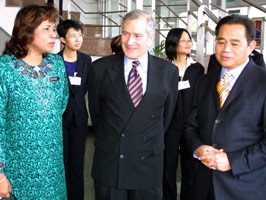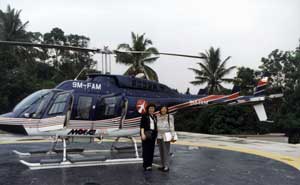“Human kind’s advances will depend increasingly on new integrative approaches to complex systems, problems, and structures. Design syntheses and synergy across traditional disciplinary boundaries will be essential elements of both education and research.”
“We have begun to prepare for this by increasing our understanding of, and partnership with, business, industry, and governments in new endeavors of learning, research, and problem solving. This will be an important element of the Research University of the Future…”
Charles Vest, (2000)
15th President of MIT
Malaysia: MALAYSIA UNIVERSITY OF SCIENCE AND TECHNOLOGY, MUST
Duration: January 1, 2002 - November 30, 2004
Overview and Impact

The Cooperative Program between MIT and MUST Ehsan Foundation for assistance in the establishment of the Malaysia University of Science and Technology (MUST) was conceived and planned as part of Malaysia's Second Industrial Master Plan in response to the Prime Minister's call for a creation of a world-class science and technology sector. The major objective of the program was to produce top quality graduate engineers who would understand and participate effectively in Malaysia's program for a balanced social and industrial development. The program was sponsored by the Ministry of Science and Technology in Malaysia and the Motorola Foundation and Motorola GTSS and GSG at MIT. MIT participation ended November 30, 2004 due to withdrawal of Motorola commitment to MIT because of economic circumstances.
MIT provided advice and assistance to MUST regarding faculty recruitment, IT infrastructure, course delivery, as well as setting up a library, academic media production services, and other critical offices needed. Many MIT faculty members were involved with the project.
As of November 2004
- MUST had hired 24 faculty members who were graduates from leading universities. It offered seven Master of Science degree programs:
Biotechnology
Construction Engineering and Management
Energy/Environment
Information Technology
Materials Sciences and Engineering
Systems Engineering and Management
Transportation and Logistics
hese degree programs were comprised of approximately 50 courses developed with MIT's assistance. - MUST had applied to the Ministry of Higher Education to start two Ph.D. programs: Biotechnology and Transportation and Logistics.
- MUST's enrollment numbered 212 and MUST graduated its first class of students in December of 2004.

Research
MIT and MUST completed nine joint research projects.
Outreach
One objective of MIT's participation was to promote cooperation among industry, academia, and government to inform industry of technological developments, and to transfer technology wherever possible. To this end, many seminars were held over MIT's two-year involvement.
Seminars Given in 2002
Intelligent Transportation Systems in the United States.
New Technologies for Monitoring, Predicating, and Controlling Red Tides and Harmful Algal Blooms.
Seminars Given in 2003
Why did NASA's Mars Climate Orbiter Satellite Get Lost?
Oxygen Tension — A Balance Between the Good and the Bad.
Enabling Technologies for Barley Genetics and Breeding.
E-Development: Technologies, Policies and Social Enterprise.
Computer Simulation for Stability of Quaternary Semiconductor Solid Solutions.
Tackling the Waste Challenge Conversion of Waste into Resource.
A New Look at Photonics Applications in Medicine, Cosmetics.
Steroselective Enzymatic Synthesis of Pharmaceutical Drug Precursors.
Value of Flexibility in Strategy and Finance.
Industrialized Building Construction in Italy : Historical Perspectives and Lessons.
Airline Revenue Management — Recent Developments and State of Practice.
Seminars Given in 2004
Kinetics of Hydrolysis of Palm Oil by Lipase.
Nano-Structures - Synthesis and Properties.
Safety Assessment of a Very Exothermie Reaction.
DNA Microarrays into Bioprocess Engineering.
Choosing the Future: Science, Technology and Public Policy.
Computer Simulation of Radiation Synthesis and Processing of Materials.
Transportation as a Complex Socio-Technical System: The Mexico City Case.
Collaborative First Response to Disasters Involving Critical Physical Infrastructure.
Virtuous Cycle Between R&D, Development and Functionality Assimilation Capacity for Competitive Strategy in Japan's High-Technology Industry.
Production of Carbon Nanotubes.
The Hardware of the Future.
Lessons Learned
As with the Masdar Institute in Abu Dhabi, Malaysia was a diversifying economy planning to move toward high value added employment generation and a strong research and development infrastructure. The cornerstone would be a research-oriented institute. Establishing a leading institute of science and technology and an overall educational infrastructure is a very complex process and dependent upon many factors, including: the host country's determination, the economy, the resources available and long-term commitment that is required for maturity of such institutions.
A few lessons learned from MUST include that financial agreements with students (scholarships) are very important to the success of these projects; student recruitment standards must remain high; government support is key; and the research must be rigorous.
MUST continues today, but without MIT's involvement.
